SAMSCA® (tolvaptan) preserves electrolytes1
- No significant change in urinary excretion of [Na+] and [K+] or plasma [K+]
- During initiation and titration, frequently monitor for changes in serum electrolytes and volume
Exposure and response - renal function
- Exposure and response to tolvaptan in healthy subjects with creatinine clearance ranging between 79 and 10 mL/min and patients with normal renal function are not different
- SAMSCA is not recommended in patients with creatinine clearance <10 mL/min because drug effects on serum sodium levels are likely lost at very low levels of renal function

The SAMSCA MOA video illustrates the relationship between vasopressin and hyponatremia, as well as the potential benefits of vasopressin V2-receptor antagonism.


